List of inventions and innovations of indigenous Americans
This is an alphabetic list of achievements in science and technology made by Indigenous peoples of the Americas during the 20,000 years or more that they have inhabited the Americas.
A
- Abstract art – abstract art was used by nearly all tribes and civilizations of North and South America. Indigenous art was believed to be primitive until the 1990s when it served as inspiration for the modern American abstract art movement. See also Visual arts by indigenous peoples of the Americas.
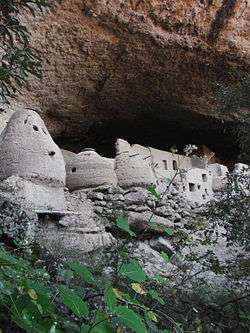
Adobe buildings at Cuarenta Casas
- Adobe – adobe was used by the peoples from South America, Mesoamerica, and up to Southwestern tribes of the U.S. It is estimated that it was developed around the year 3000 BCE.
- Agave wine – is made from the same plant, blue agave, as tequila but with a lower alcohol content.
- Almanacs – almanacs were invented independently by the Maya peoples. Their culture arose and they began using them around 3,500 years ago, while Europeans are known to have created written almanacs only after 1150 CE. Almanacs are books containing meteorological and astronomical information, which the Maya used in various aspects of their life.
- Alpacas – the Andean civilizations were amongst the first to domesticate alpacas.
- American football – the Iroquois claim to have played football. While no specification is made as to whether this is meant to be American football or soccer. Soccer is said to have been invented in Asia.[1]
- Anesthetics – Indigenous peoples used coca, peyote, datura and other plants for partial or total loss of sensation or conscious during surgery. Western doctors had effective anesthetics only after the mid-19th century. Before this, they either had to perform surgery while the patient felt pain or knock the patient out.
- Apartment blocks – the Ancestral Puebloans (Anasazi) and other tribes which once thrived in the present day Southwest of the US, developed complex multistory apartment complexes, some of which are still in use today. Pueblo communities in present-day New Mexico continue to reside in some of these ancient multistory apartment complexes which were constructed by their ancestors many centuries ago, even before the first apartments were built in the United States during the 18th century. Pueblo Bonito, one of the seminal archaeological sites today is a example of this indigenous multistory apartment complex construction technology from the Anasazi and Hohokam time periods about a thousand years ago.

Nazca monkey
- Art to be viewed from space – the Nazca Lines were created by the ancient Nazca culture in modern-day Peru. The Nazca built these artworks, which could only be viewed from the sky or from space. It was as if the Nazca were building monuments, which only their gods could view from up in the sky. Some of these artworks, otherwise known as the Nazca Lines, could only be viewed from the sky and each one of these works of Nazca art spans several miles across in size and dimension in the Sechura Desert.
- Aqueducts – the ancient Andean cultures such as Chimu and the Moche lived in very dry environments. Yet, despite the dryness of the areas where they resided, they were able to thrive, build great cities, towns, and civilizations. This was largely due to farming in these dry regions, which these peoples engaged in and farming is largely dependent upon the availability of fresh water. Using extensive aqueducts, they were able to transport water from the rivers, mountain streams, and lakes to their fields and build the food base required for building great civilizations. The Inca later expanded on these already constructed aqueducts and built even more complex and large aqueduct system in the Inca Empire. The Mesoamerican Aztecs also constructed complex aqueducts to bring water to their vast city of Tenochtitlan.
- Aspirin – indigenous Americans have been using willow tree bark for thousands of years to reduce fever and pain as were the peoples of Assyria, Sumer, Ancient Egypt and Ancient Greece. When chemists analyzed willows in the last century, they discovered salicylic acid, the basis of the modern drug aspirin.[2]
- Atlatl – Paleo-Indians (Beringian Diaspora) from over 11,500 years ago had developed a highly developed spear thrower in the form of the atlatl to hunt woolly mammoths, giant sloths, mastodon, muskox (euceratherium), giant beaver, early caribou, steppe bison, saber-toothed cat, and other Pleistocene animals. Using the atlatl, these ancient Paleo-Indians were able to traverse much of the Americas from Alaska down to Mexico and Central America and into South America, all the way down to Chile as they hunted and followed these Pleistocene megafauna within a short 3,000 year time period from about 14,500 years ago to about 11,500 years ago.[3]
- Avocado – indigenous Americans were the first to domesticate and grow avocado.[4]
B

Solid rubber ball
- Balls, rubber – the Olmecs produced rubber balls around 1700 BCE. They were the first people to develop and play with rubber balls as well as manufacture other objects of rubber.
- Beans – most commonly eaten beans today, were originally cultivated in the Americas by indigenous Americans. Beans (Phaseolus) along with squash and maize formed the "Three Sister (crops)" which were grown by many pre-Columbian American cultures, tribes, nations, and civilizations.
- Bottle gourds – the ancient Mexicans learned to first cultivate the bottle gourds around 8,000 BCE. Indigenous peoples raised bottle gourds for use as bowls, scoops, colanders, ladles, spoons, canteens, and dippers. Larger gourds were used as cooking vessels. The indigenous peoples of the Eastern Woodlands hung bottle gourds on poles in their cornfields to serve as habitats for insect-eating birds (a form of biological pest control, which they developed). Indigenous Americans in northern Peru also used bottle gourds as floats for fishing nets.
- Bulletproof vest – while Kevlar and modern additions were invented by Europeans, the original bulletproof vest was accidentally invented by the Aztecs. It was made with a framework of cloth soaked in salt water, paper-mached into a thick vest and sun-dried. While intended to stop spears thrown by atlatl, the Spanish soon discovered that they also stopped musket shot. After defeating the Aztecs, most Europeans borrowed the idea, making metal armor a thing of the past. The only supposed downside was that they were itchy, hot and uncomfortable to wear.[5]
- Bunk bed – the Iroquoian longhouses housed several families together. The concept of bunk beds was developed by these Native American peoples, since these longhouses included several bed combinations which featured one bed built on top of another akin to bunk beds in the modern era.
C
 The Aztec Calendar
The Aztec Calendar- Calendars – were developed by indigenous Americans throughout North America, Mesoamerica, and South America. They are known to have been in used since 600 BCE. Some calendars were so precise that by the 5th century BCE they were only 19 minutes off.
- Canals –the Aztecs built great canals used for transporting food, cargo, and relaying people to the chinampas (floating gardens used for growing food) in their great metropolis of Tenochtitlan.
- Canoe – many indigenous nations including the Caribs, Cree, Iroquois, and others had developed many distinct forms, styles, and types of canoes over the millennia.[6]
- Cassava – the first cultivation of cassava.
- Causeway – the Aztecs built many giant causeways that connected the mainland to their capital city of Tenochtitlan located in the heart of the Aztec Empire. The causeways served as arteries used for transporting food, goods, people, prisoners, and wastes during the heyday of the Aztec Empire during the 14th century to the 16th century.
- Chaps – these appear to have been first used as a sort of leather armor to protect the legs from injury during guerrilla attacks by east coast native peoples. Some of these peoples ended up migrating to Texas shortly before the Texas Revolution, where it appears that others discovered that wearing chaps over pants reduced chaffing on long horseback rides and it came to be adopted by US, Mexican and indigenous horse-riding cultures.
- Chewing gum – Native Americans in New England introduced the settlers to chewing gum made from the spruce tree. The Mayans, on the other hand, were the first people to use latex gum; better known to them as chicle.
One of the few remaining chinampa at Xochimilco
- Chinampa – floating gardens which were highly productive areas used for farming and growing food, were constructed by the Aztecs to provide food and sustenance to their 250,000 inhabited city of Tenochtitlan. The Aztecs used the chinampas in and around Tenochtitlan to grow corn, squash, beans, tomato, avocado, chill, peppers, and all others sorts of food products to feed the burgeoning population of their great metropolis.
- Chocolate – the Maya civilization were the first to drink cocoa. This tradition was later passed on to the Aztecs who called the beverage xocalatl. Indigenous people in Mesoamerica introduced it to the Spanish and Portuguese, but they kept the beloved xocalatl from the rest of Europe for nearly a century.
- Chunkey – a Native American game where a person rolls a hoop covered in a leather strap framework and tries to hit it with spears or arrows. This may have inspired the sport of skeet shooting.[7]
- Corn (maize) – the domestication of maize, now cultivated throughout the world, is one of the most influential technological contributions of Mesoamericans.
- Compulsory education – the Aztec Triple Alliance, which ruled from 1428 to 1521, is considered to be the first state to implement a system of universal compulsory education.[8][9]
- Corn beer – made in the Andes it is of pre-Incan origin from the Wari culture.
- Cornmeal –
- Cranberries – Native Americans were the first to domesticate and grow cranberries.[4]
D

Detail of Nezahualcóyotl's dam to control water levels around Tenochtitlan
- Dams – the Aztecs in Tenochtitlan constructed great dams during the heyday of the Aztec Empire. Tenochtitlan, the capital of the Aztec empire, was first built on a small island that was located in the western section of Lake Texcoco in 1325 CE. The Aztecs created a large artificial island around the small island using a system that was similar to building the chinampas (floating gardens in the lake that was used to grow food for the cities' population). To provide drinking water to the cities' population of over a quarter of a million inhabitants, the Aztecs built a system of dams that separated the salty waters of the lake from the rainwater that was accumulated during periods of heavy rains. The Aztecs also used the dam to control the level of water in the lake and prevent their city from being flooded during times of heavy rains. To prevent flooding, the Aztecs constructed an inner system of channels that helped to control the water level and held the level steady during flooding and periods of intense rains. Hernán Cortésand the other Spanish conquistadors destroyed these engineering marvels that the Aztecs had developed during the previous 200 years.
- Dog breeds – Native American dogs believed to have been bred by indigenous Americans are the xochiocoyotl (coyote), xoloitzcuintli (known as xolo or Mexican hairless), chihuahua, Peruvian Hairless Dog, the Carolina Dog, Canadian Eskimo Dog, and the Alaskan Malamute.
E
.jpg)
- Electroplating – the Moche independently developed electroplating technology without any Old World influences. The Moche used electricity derived from chemicals to gild copper with a thin outer layer of gold. In order to start the electroplating process, the Moche first concocted a very corrosive and a highly acidic liquid solution in which they dissolved small traces of gold. The technique also involved copper, which was then inserted into the resulting acidic solution. The copper then acted both as a cathode and an anode, and this generated the necessary electric current needed to start the electroplating process. The gold ions in the solution were attracted to the copper anode and cathode and formed a thin layer over the copper, giving the latter the appearance of a solid gold object, even though gold only coated the outermost layer of the copper object. The Moche then allowed the acidic solution to boil slowly, causing a very thin layer/coating of gold to permanently coat the copper anode and cathode. This advanced electroplating technique was developed during 500 CE by the Moche, a thousand years before Europeans invented the same process.
- Embalming – Egyptians are known for mummification, which began around 6000 BCE to 600 CE. In what is now Chile, however, the Chinchorro peoples are known to have been embalming and mummifying their dead since around 5000 BCE. Embalming is using preservatives to prevent decay of the body. Many other indigenous American peoples further perfected the art of embalming and mummification including the skilled Moche peoples in present-day Peru.
- Ephedra – the Aztecs used ephedra in order to treat common colds. Unlike the Chinese version of the ephedra, the New World ephedra that was used by the indigenous Americans contained milder alkaloids.
F
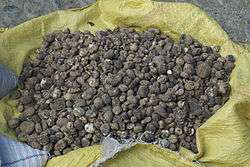
Chuño, a freeze dried potato
- Freeze-drying – The Andean civilizations learned to freeze dry potatoes (chuño) and other food items, so that the resultant dehydrated powder could be stored for years and then later transported across vast distances to feed countless hungry peoples. The Spanish conquistadors used this Andean invented freeze-drying technique to transport several tonnes of dehydrated potatoes across the Atlantic Ocean back to Europe to feed hungry Europeans.[10]
G
- Gold plating – the Moche dissolved gold using an alum/saltpetre/salt mixture which was then deposited onto copper vessels.[11][12]
- Green bean – this, as well as other varieties, were first farmed in South America and migrated to North America where it was adopted by Europeans.
- Guinea pigs – Indigenous South Americans had domesticated the guinea pig as a food source around 9,000 to 6,000 BCE. The Inca people took guinea pig farming to new heights.
.jpg)
Two guinea pigs
H
- Hammocks – hammocks were commonly used in the Caribbean, South and Central America at first contact with Europeans. The Spanish liked the comfortable way of sleeping and adopted them. Europeans eventually used them as the primary way of sleeping on ships.
- Harpoons – the Inuit had developed the harpoon independent of any Old World influences, in order to hunt seals, walrus, and whales. The Inuit of West Greenland called the harpoon, maupok. Harpoons enabled the Inuit to hunt large marine mammals from a distance in the umiak and kayak in the open Arctic Ocean.
- Hominy – this is a specialized corn dish known by many North American native people. Today, it is most commonly seen in the Southern United States.[13]
- Hockey – Both field hockey and ice hockey are based on a game called shinny. This indigenous stickball game was played throughout North America well before the European arrival.
- Horse breeds – Appaloosa and Pinto.
I
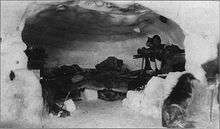
Inside an igloo
- Igloos – built by the Inuit, igloos were constructed for many centuries as a form of protection and shelter to house people from the harsh Arctic weather. While the temperature outside an igloo may have been −45 °C (−49 °F), the temperature within an igloo was stable ranging from −7 to 16 °C (19 to 61 °F) when warmed by body heat. The Central Inuit people in Northern Canada (especially those, who lived around the Davis Strait), lined the inside living area of an igloo with animal skin and hides. This assisted in increasing the temperature within an igloo from around 2 °C (36 °F) to 10–20 °C (50–68 °F), thereby insuring a more comfortable existence for the inhabitants of the igloo from the fierce cold outside. With the addition of a kudlik the temperature could be raised even more.
- Inca road systems – the Inca built one of the most extensive road systems in the ancient world. The Incas built upon the roads, which were originally constructed by previous Andean civilizations such as the Chimu, Nazca, Wari, Moche, and others. The Inca also further refined and expanded upon the earlier innovations and systems laid in place by previous Indigenous cultures. The Incan road system, at its peak, spanned over 20,000 mi (32,000 km) and criss crossed mountains, rivers, deserts, rainforests, and plains. The road system connected the empire from the Andes mountain in Colombia all through Ecuador, Peru, Bolivia, northeastern Argentina, and present-day northern Chile. The Inca roads were used to transport food, goods, people, and armies, while Inca officials frequently relayed messages using the roads across the vast stretches of the Inca Empire. In areas, where rivers blocked the directions of the roads, the Inca constructed elaborate and complex rope bridges.
- Inuit snow goggles – the Inuit made snow goggles which protected their eyes against the harsh winds in the Arctic regions of North America, long before sunglasses became available to modern Europeans.
_and_Caribou_antler_1000-1800_CE_(bottom).jpg)
Snow goggles
J
K
- Kayak – originally developed by the Inuit, Yupik, and Aleut to hunt on inland lakes, rivers and coastal waters of the Arctic Ocean, North Atlantic, Bering Sea and North Pacific oceans
L
 Llama overlooking Machu Pichu
Llama overlooking Machu Pichu- Lasso – the Lenape and early settlers allegedly record the use of the lasso as a sort of snare to trap large game. The Lenape eventually brought this to Texas, where it came to be implemented by the American and Mexican cowboy cultures.
- Lacrosse – lacrosse may have developed as early as 1100 CE among indigenous peoples on the North American continent.
- Llamas – Indigenous people from Peru domesticated llamas in around 5000 BCE.
M
- Maize – first cultivated in present-day Mexico several thousand years ago, corn is currently the most cultivated grain in the world with the US being the largest cultivator of maize followed by mainland China. Over 700 million tons of maize are grown worldwide annually today in order to feed people and animals. In addition, ethanol extracted from corn is also used to fuel engines in millions of vehicles, thousands of planes, and other engines throughout the world.
- Manioc – Native Americans were the first peoples in the world to cultivate manioc.[10]
- Maple syrup and maple sugar – indigenous Americans were the first to extract the sap from maple trees and convert the sap into maple syrup and maple sugar.[4]
- Mathematics – the Olmecs and the Mayans, who came after them, independently developed the concept of zero (independent of the ancient Hindus in India) in mathematics. The ancient Mexicans also developed complex arithmetic functions and operations such as additions, subtractions, divisions, and multiplications. The development of mathematics by the Mexicans complemented and assisted them in making sense of the universe, cosmos, astronomy, and pre-Columbian calendars that were so essential in maintaining a connection between them and the gods and heavens.
- Metallurgy in pre-Columbian America – many pre-Columbian cultures, especially the Moche in the Andean regions were skilled metallurgists. Indigenous Americans mastered smelting, soldering, annealing, electroplating, sintering, alloying, low-wax casting, and many other metallurgical techniques independent of any Old World influences. The Moche were skilled in hammering and shaping gold, silver, and copper into intricate ornamental objects, while the later Incas developed more utilitarian objects using these metals and alloys. Metallurgical techniques later diffused from the Andean region of South America to Colombia and then later to Mesoamerica, where local artists and metallurgists developed even more unique techniques using a wide range of material, including alloys of copper-silver, copper-arsenic, copper-tin and copper-arsenic-tin.
- Moccasins – highly comfortable shoes used by indigenous Americans to travel vast distances. These shoes were often made of leather and were highly comfortable to wear. In addition, the moccasins could withstand the rugged terrain over which Native Americans traversed.
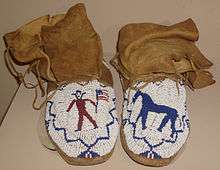
Beaded moccasins originally from the estate of Chief Washakie, Wind River Indian Reservation (Shoshone), Wyoming, c.1900
- Muscovy duck – indigenous peoples were the first in the world to domesticate the muscovy duck.
P
- Painting – Mayan paintings from the ancient era found in the archaeological sites, such as Cacaxtla and Bonampak are some of the most refined paintings ever to come out of the ancient Americas. Besides the Mayans, other indigenous civilizations were also known for their wall paintings including the Aztecs and the Navajo, who developed the art of sand painting.
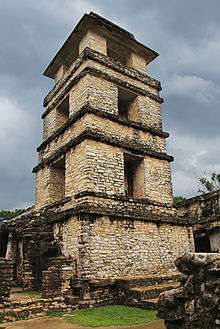
The palace observation tower at Palenque
- Palaces – indigenous American civilizations such as the Olmecs, Mayans, Zapotecs, Aztecs, Mixtecs, Moche, Toltecs, Inca, Chimú, Nazca and many more built elaborate palaces. The Mayan palace in Palenque is one of the best examples of Mayan palace architecture there is.
- Parkas – the Inuit in the Arctic were the first peoples in the world to develop parkas. Parkas are great insulators, which protected the Inuit against the harsh Arctic winter. The pocket of air that was located within sewed caribou fur in a parka, protected a person against the brutal Arctic winter.[10]
- Papaya – indigenous people residing around the Caribbean Sea and Mexico, such as the Mayans had been the first to domesticate and grow papayas.
- Peanuts – indigenous Americans were the first peoples in the world to cultivate peanuts.[10]
- Pemmican – indigenous Americans were the first to develop pemmican as a nutritious and high-energy food.[4]
- Pepper – the indigenous Americans were the first to cultivate peppers of all kinds including chili peppers of all types and sweet red, green, yellow, and all other colorful hues of non-chilli peppers. Peppers were first cultivated by the indigenous Americans in Mesoamerica.
- Petroleum – Native Americans in present-day Pennsylvania, the Iroquois, lit petroleum, which seeped from underground to fire ceremonial fires. In addition, they also used petroleum to cover their bodies against insect bites and as a form of jelly to prevent their skins from drying out.[14]
- Peyote – indigenous people realized the antibiotic property of peyote and used the extract to treat fevers and enhance the energy in their bodies and treatment as an anesthetic.
- Pineapple – indigenous people residing in what is now Brazil and the Paraná River valley of Paraguay were the first to cultivate the pineapple. From there, pineapple cultivation spread to Mexico, Central and South America and the Caribbean. Indigenous Americans used the pineapple as a source of food.
- Planned city construction – ancient cities in Mexico such as Teotihuacan and the Aztec capital of Tenochtitlan incorporated planned city design including streets laid out in a grid pattern.
- Popcorn –
- Potato chips – George Crum, a half-black, half-Native American cook, was believed to have invented the potato chip, however that myth seems to be misleading. Crum's purported invention of potato chips became most firmly set after a 1973 advertising campaign by the St. Regis Paper Company, which manufactured packaging for chips. A large ad featuring Crum and his "story" was published in the national magazines, Fortune and Time. It was in the latter 1970s that the variant of the story featuring Cornelius Vanderbilt became popular because of the interest in his wealth and name, and evidence suggests the source was advertising agencies for the Potato Chip/Snack Food Association.[15][16]
_01.jpg)
Teotihuacan incense burner lid
- Potato – first cultivated in the Andean regions of South America by Andeans. It was first cultivated in Peru and Bolivia.
- Pot roast – in one of the Lakota legends recorded in Lakota mythology, the character Wohpe is seen creating a dish in the exact same manner as we make pot roasts today—sealing a large chunk of meat and vegetables in a bag and steaming it in a pot.[17]
- Pottery – many indigenous American cultures and peoples independently invented and then developed pottery in the Americas into fine works of art as well for utilitarian usage. The Moche and Mayans were some of the best potters from the ancient Americas, and their work still inspires awe amongst us for the level of artistry, creativity, and sophistication which such highly prized works of arts involved. The Navajos are also very skilled developers of pottery and their works in the present time are highly detailed and much prized. Many other indigenous American cultures also developed their own pottery styles during the ancient time periods and continued to refine their artwork into the modern era.
- Pulque – corn-based alcoholic beverage created in Mesoamerica sometimes called agave wine. Still popular in Mexico today.[5]
- Pumpkins – indigenous Americans were the first to domesticate and grow pumpkins.[4]
- Pyramids – high civilizations in Mexico such as the Toltecs, Olmecs, Zapotecs, Aztecs, Mayans, Mixtecs, developed their own myriad styles of pyramids, usually step pyramid, which served as ceremonial, religious, and administrative functions. One of the largest pyramids in the Americas were constructed by the people in the ancient Mexican city of Teotihuacan. In the Andean regions, the Moches, and some ancient Peruvians also constructed gigantic pyramids as well without any influence from Old World civilizations.
Q
- Quinoa – first grown and cultivated in the Andes. This is a food grain which the indigenous Americans first developed and the grain is considered to be one of the most nutritious items there is.
- Quinine – a muscle relaxant, which has been used for many centuries by the Quechua people in the Andes area of South America. The medicine was used by many Andean people to prevent shivering due to cold in the low-temperature areas in the high Andes mountains of Peru. The ancient Peruvians would mix the ground bark of cinchona trees with water to eliminate the bark's bitter taste, and then drink the resultant tonic water to soothe their nerves and senses.
- Quipu – quipus were developed by the ancient Andeans. Quipus mimic an accounting, record-keeping, and communication system that uses knots and strings in order to record valuable information related to population, economic data, food grain supplies, calendars, events, etc.
R
- Rubber – the indigenous cultures of Mesoamerica were the first peoples in the world to extract the sap from rubber trees and then use it to make clothes, rubber balls to be played in ceremonial ball games, and many other utilitarian uses. Indigenous peoples, especially those who lived in the Amazon rainforest found many other uses for rubber. The science and technique of extracting sap from rubber trees and then using the sap to make goods made of rubber then spread to the high civilizations of the Andes and elsewhere in the Americas.
- Rubber balloons – The Olmecs were the first people to use rubber balloons. Their civilization arose in BCE 1700 in the Yucatán Peninsula.[18]
- Reed boats – A balsa was a boat that was constructed by pre-Columbian South Americans from woven reeds of totora bullrush. These reed boats varied in size from that of a small canoe used for navigation, transportation, and for small-scale fishing to large ships of up to 30 m (98 ft) in length, which were used for transporting royalty and nobility, war, transportation, and bulk goods hauling. They are still used today on Lake Titicaca in Peru and Bolivia by the indigenous peoples living along the banks of the lake.
S
- Salsa – one of several sauces typical of Mexican cuisine.
- Smoking pipe – indigenous Americans invented the smoking pipe and in particular the ceremonial pipe a type of tobacco pipe. This was an unknown concept to Europeans and the idea was adopted by them and was shortly thereafter brought to the Chinese.
- Snowshoes – invented and then used first in the Americas by the indigenous tribes, which resided in the cold areas of North America in order to travel across a snow-laden landscape, especially during the long winter months, that gripped all of the region.
- Spinning top – known from Mesoamerican times. A device used as a toy and made out of wood.[19]
- Spruce beer – an beverage made using pine needles. Also called pine beer and nettle beer. Probably brewed originally by First Nations and predates Europeans.[20]
- Squash – the people of southern Mexico were the first to grow squash. Squash along with maize (corn) and beans represented the three sister crops of the ancient Mesoamericans.
- Sundials – the Inca and other pre-Columbian Americans constructed elaborate sundials for both ceremonial and religious purposes, but also for record keeping.
- Sunflower – indigenous Americans were the first peoples in the world to cultivate the common sunflower.[10]
- Suspension bridge – the ancient Mayans constructed a suspension bridge over the Usumacinta River in Yaxchilan. This Maya Bridge at Yaxchilan would have been one of the longest bridges in use in the ancient past. The bridge was constructed in the 7th century CE and was a very long suspension bridge with a relatively level pathway.
- Syringe – indigenous American medicine men used syringes and hypodermic needles made from materials fashioned from hollow bird bones and animal bladders to inject medicine into sick patients and treat the illness of the patients, centuries before syringes were even invented in the West.[10]
T
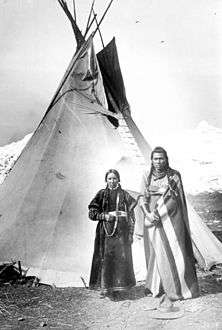
Nez Perce tipi
- Tamales – although largely associated with Mexico, records from the Iroquoian people show that they too made such a dish.[13]
- Tipi – a cone-shaped, portable dwelling popularized by Plains Indians (Native Americans and First Nations) of the Great Plains and the Canadian Prairies. Tipis were warm, durable and comfortable and could be easily broken down and packed. A settlement could be ready to move in about one hour.
- Tlingit Armor – The Tlingit armor is worn by coastal Indigenous Nation in Alaska and British Columbia. Tlingit warriors wore battle helmets depicting crest animals or ancestors, along with wooden visors, thick leather tunics, and body armor covered with wooden slats or coins. This battle attire combines technology, ingenuity, and symbolic power and protection.
- Tobacco – tobacco was used in the Americas for many centuries prior to the arrival of white Europeans. Consumed in high doses, tobacco can become highly hallucinogenic and was accordingly used by many indigenous peoples in the Americas to inspire dreams and dream time. Tobacco was also often consumed as a medicine amongst some tribes, although this was strictly practiced by experienced shamans and medicine men. Eastern tribes in the mainland US also traded tobacco as a trade item in exchange for food, clothing, beads, and salt and would often smoke tobacco during sacred and ritualized ceremonies using pipes. Tobacco was considered to be a gift from the gods and it was believed that the exhaled tobacco smoke generated from smoking a pipe would carry one's thoughts and prayers to the creator up above in the heavens.
- Toboggan – the Innu and the Cree nations of Canada developed a sled in the form of the toboggan. These sleds were used to transport people and cargo across the snow using dogs as draft animals. Sled dogs such as Huskies were used to pull the dog sled along the harsh Canadian winter snows.
- Toggling harpoon – first used by the Red Paint People of the North American east coast they were later used by the Thule.
- Tomato – indigenous Americans were the first peoples in the world to domesticate and then grow the tomato.The tomato was an essential ingredient that formed the basis of many indigenous foods including tamales, tostado, soups, and salads. Indigenous Mesoamericans were the first peoples in the world to cultivate the tomato several thousand years ago.
- Tortillas – this staple food well known today was used throughout Mesoamerican and Southwestern US cultures. Although they were mainly made of corn, squash and amaranth were also popular. The tortillas were wrapped around different fillings such as avocado. Today this has resulted in the creation of the modern taco, burrito, and enchilada.
- Tug of war – The Iroquois claim tug of war was once related to some sort of celebratory ritual they used to do.[1] The Mohave people occasionally used tug-of-war matches as means of settling disputes.[21]
U
An ulu in the western Arctic style
- Umbrellas – independent of the ancient Chinese (who had also invented the umbrellas on their own), the Mayans and the Incas had invented circular umbrellas, which were made from bird feathers.
V
- Vanilla – the Totonac are believed to be the first to extract vanilla from the pods of vanilla orchids and use it as a special form of flavor.[10]
- Vulcanization – the Olmec people of Veracruz, Mexico treated the sap from rubber trees with chemicals and shaped the resulting rubber into a myriad of products such as balls, sandals, balloons, rubber syringes, etc. centuries before Charles Goodyear re-invented the process during the 19th century.
W
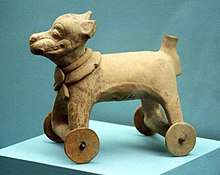 An Aztec toy dog on wheels
An Aztec toy dog on wheels- Water gun – some of the first water guns were more of a syringe-type device. The missionary Eugene Buechel recorded the Lakota peoples as making such toys for their children out of log rounds. However, whether or not they actually invented the device is up for debate.[22]
- Whaling – indigenous peoples such as the Inuit have been whaling for many centuries using boats. Their whaling tradition in the Arctic region predates European colonization of the Americas.
- Wheel and axle – It has been argued that indigenous Mesoamericans had invented the wheel. The oldest wheeled figure to have been uncovered, in Mesoamerica, is a crowned, dog-like figure in Tres Zapotes, Veracruz, dated ca. 100-200 CE. However, the most common examples of the Mesoamerican wheel and axle are the excavated Aztec clay wheeled "toys".
- Whoopee cushion – Natives to the great plains were known to use animal bladders as whoopee cushions to play practical jokes on others. They were so popular, a common Lakota myth actually depicts a sorcerer using an animal bladder to put a spell of flatulence on a girl who spurned him.[17]
- Wigwam – A wigwam, wickiup or wetu is a domed room dwelling formerly used by certain Native American and First Nations tribes, and still used for ceremonial purposes. The wigwam is not to be confused with the Plains tipi which has a very different construction, structure, and use.
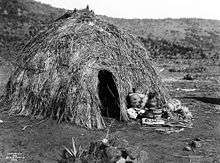
Apache wickiup, by Edward S. Curtis, 1903
- Writing system – Many indigenous American cultures such as the Olmecs, Mayans, Aztecs, Zapotecs, and Toltecs had developed their own unique writing system independent of any Old World influences. Other native peoples to the north—mainly Algonquians—had organized pictographing that was close to evolving into a writing system, but was not yet there. The Mi'kmaq used a hieroglyphic writing system prior to European arrival,
Y
See also
- List of pre-Columbian cultures
- Domesticated plants of Mesoamerica
- Agriculture in Mesoamerica
- Mesoamerican cuisine
- Mesoamerican diet and subsistence
- Mesoamerican architecture
- Indigenous music of North America
- Painting in the Americas before European colonization
Notes
- 1 2 Froman, Frances & Keye, Alfred J. "English-Cayuga/Cayuga-English Dictionary" 2014.
- ↑ "The Science of Asprin and Willows".
- ↑ Paleo-Indians
- 1 2 3 4 5 6 https://www.nrcs.usda.gov/Internet/FSE_DOCUMENTS/nrcs141p2_024206.pdf
- 1 2 Phillips, Charles "The Complete Illustrated History of the Aztec & Maya: The Definitive Chronicle of the Ancient Peoples of Central America & Mexico - Including the Aztec, Maya, Olmec, Mixtec, Toltec & Zapotec" 2015.
- ↑ Canoe
- ↑ "Chumash Indians-Sports and Recreation". Retrieved 2008-09-16.
- ↑ Jacques Soustelle (11 November 2002). Daily life of the Aztecs: on the eve of the Spanish Conquest. Courier Dover Publications. p. 173. ISBN 978-0-486-42485-9. Retrieved 27 November 2012.
- ↑ Wikipedia: Aztec#Education
- 1 2 3 4 5 6 7 8 "16 Indian Innovations: From Popcorn to Parkas".
- ↑ H. Lechtman, "A Pre-Columbian Technique for Electrochemical Plating of Gold and Silver on Copper Objects," Journal of Metals 31 (1979): 154–60
- ↑ New perspectives on Moche Metallurgy: Techniques of Gilding Copper at Loma Negra, Northern Peru , Heather Lechtman, Antonieta Erlij, and Edward J. Barry online abstract via www.jstor.org
- 1 2 Chafe, Wallace L. "Handbook of the Seneca Language (North American Indian Languages Edition)" 2007.
- ↑ Early Native American Oil Discoveries
- ↑ George Crum
- ↑ Fox, William S.; Banner, Mae G. (1 January 1983). "Social and Economic Contexts of Folklore Variants: The Case of Potato Chip Legends". Western Folklore. 42 (2): 114–126. doi:10.2307/1499968. JSTOR 1499968.
- 1 2 Jahner, Elaine A. & DeMallie, Raymond J. "Lakota Myth" 2006.
- ↑ Encyclopedia of American Indian Contributions to the World
- ↑ Encyclopedia of American Indian Contributions to the World
- ↑ Ebberts, Derek (9 March 2015). "To Brew or Not to Brew: A Brief History of Beer in Canada". Manitoba Historical Society. Manitoba Historical Society. Retrieved 28 January 2017. "Quebec was the geographic epicentre of the development and expansion of the brewing industry in Canada."
- ↑ Homicide, Race, and Justice in the American West, 1880-1920, Page 133.
- ↑ Buechel, Eugene & Manhart S.J., Paul "Lakota Dictionary: Lakota-English / English-Lakota, New Comprehensive Edition" 2002.
References
- Keoke/Porterfield. Encyclopedia Of American Indian Contributions To The World.New York, NY: Facts On File, 2002.
This article is issued from
Wikipedia.
The text is licensed under Creative Commons - Attribution - Sharealike.
Additional terms may apply for the media files.
